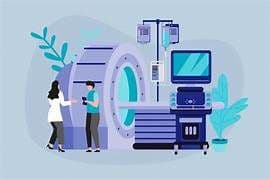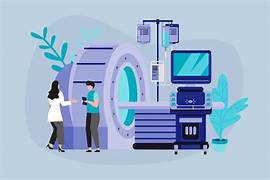
The Physics Behind Medical Imaging Technologies
Introduction
Medical imaging technology plays a crucial role in the diagnosis and treatment of various medical conditions. It allows healthcare professionals to visualize internal structures, detect abnormalities, and monitor the effectiveness of treatments. Behind the scenes, applied physics plays a fundamental role in the development and advancement of medical imaging technologies. In this article, we will explore how applied physics contributes to medical imaging and its impact on healthcare.
The Basics of Medical Imaging
Before delving into the role of applied physics, let's briefly understand the basics of medical imaging. Medical imaging techniques involve capturing images of the human body to visualize its internal structures. These images assist doctors in making accurate diagnoses and developing treatment plans. Some commonly used medical imaging modalities include X-ray, computed tomography (CT), magnetic resonance imaging (MRI), ultrasound, and positron emission tomography (PET).
Medical imaging technologies rely on various physical principles to create images. Applied physics provides the theoretical framework and practical knowledge needed to develop and optimize these imaging modalities. Let's explore the role of applied physics in some of the key medical imaging technologies:
X-ray Imaging
X-ray imaging, one of the oldest and most widely used techniques, relies on the properties of X-rays. X-rays are electromagnetic radiation with high energy that can penetrate the human body. Applied physics helps in understanding the behavior of X-rays, their interaction with different tissues, and the design of X-ray machines to produce high-quality images while minimizing radiation exposure.
Computed Tomography (CT)
CT scans utilize X-rays and advanced mathematical algorithms to create detailed cross-sectional images of the body. Applied physics plays a crucial role in the design and optimization of CT scanners. It involves understanding the principles of X-ray generation, radiation detection, data acquisition, and image reconstruction algorithms. By applying physics principles, researchers and engineers can enhance the resolution, speed, and safety of CT scans.
Magnetic Resonance Imaging (MRI)
MRI utilizes a powerful magnetic field and radio waves to generate detailed images of the body's internal structures. Applied physics is fundamental to the development of MRI systems. It involves concepts such as magnetic resonance, signal generation and detection, gradient fields, and image reconstruction algorithms. By advancing our understanding of these physical phenomena, applied physicists contribute to the continuous improvement of MRI technology.
Ultrasound Imaging
Ultrasound imaging uses high-frequency sound waves to create real-time images of the body's organs and tissues. Applied physics is integral to the design and optimization of ultrasound systems. It includes the understanding of sound wave propagation, reflection, and absorption, as well as the development of transducers and signal processing techniques. Applied physicists work on improving image quality, resolution, and the ability to visualize deep structures.
Advancements in Medical Imaging Technology
Thanks to ongoing advancements in applied physics and medical imaging technology, significant progress has been made in recent years. Here are some notable advancements:
Multimodal Imaging
Researchers are exploring the integration of multiple imaging modalities to obtain complementary information. For example, combining MRI and PET scans allows for the simultaneous assessment of both anatomical structures and metabolic activity. Applied physics plays a vital role in the development and optimization of these multimodal imaging techniques.
Functional Imaging
Functional imaging techniques, such as functional MRI (fMRI) and diffusion tensor imaging (DTI), provide insights into the functioning of the brain and other organs. Applied physics helps in developing imaging sequences and algorithms to capture and analyze functional and diffusion-related data, enabling a deeper understanding of physiological processes.
Image-Guided Interventions
Applied physics has revolutionized image-guided interventions, where medical procedures are performed with real-time imaging guidance. Techniques such as fluoroscopy, ultrasound-guided interventions, and image fusion systems have greatly improved the accuracy and safety of these procedures. Applied physicists work closely with medical professionals to develop innovative imaging techniques and real-time visualization tools, enhancing the precision and success rates of interventions.
Radiation Dose Reduction
One significant concern in medical imaging is the exposure of patients to ionizing radiation. Applied physics plays a crucial role in optimizing imaging protocols and developing new technologies to reduce radiation doses while maintaining image quality. Through the use of advanced algorithms, dose monitoring systems, and dose reduction strategies, applied physicists contribute to safer imaging practices.
Image Processing and Analysis
The field of medical imaging relies heavily on image processing and analysis techniques to extract meaningful information from acquired images. Applied physics provides the foundation for developing algorithms that enhance image quality, improve segmentation, enable quantitative measurements, and support computer-aided diagnosis. These advancements aid radiologists and clinicians in making accurate interpretations and decisions.
Image Reconstruction and Artifacts Reduction
In medical imaging, image reconstruction techniques are essential for converting acquired data into high-quality images. Applied physics research focuses on developing advanced algorithms for image reconstruction that reduce artifacts, improve spatial resolution, and enhance image clarity. By addressing these challenges, applied physicists contribute to the continuous improvement of image quality and diagnostic accuracy.
Conclusion
Applied physics plays a pivotal role in the field of medical imaging technology. By understanding and harnessing the underlying physical principles, applied physicists contribute to the development, optimization, and advancement of imaging modalities. Through their research and innovation, medical imaging technologies have become more precise, safer, and capable of providing crucial diagnostic information to healthcare professionals.
In conclusion, the collaboration between applied physicists and medical professionals drives the evolution of medical imaging technology. The continuous advancements in applied physics enhance the accuracy of diagnoses, facilitate image-guided interventions, and improve patient outcomes. As we move forward, the synergy between applied physics and medical imaging will continue to revolutionize healthcare and pave the way for new discoveries and innovations.
FAQs (Frequently Asked Questions)
What is the role of applied physics in medical imaging?
Applied physics provides the theoretical framework and practical knowledge required to develop and optimize medical imaging technologies. It involves understanding the physical principles behind different imaging modalities and applying them to enhance image quality, resolution, and safety.
How does applied physics contribute to radiation dose reduction in medical imaging?
Applied physics researchers work on optimizing imaging protocols, developing dose monitoring systems, and designing new technologies to reduce radiation doses while maintaining image quality. This contributes to safer imaging practices and minimizes the potential risks associated with ionizing radiation.
What are some recent advancements in medical imaging technology?
Recent advancements include the integration of multimodal imaging techniques, functional imaging for studying organ function, and image-guided interventions. Applied physics research drives these advancements, improving the accuracy, precision, and capabilities of medical imaging technologies.
How does image processing and analysis impact medical imaging?
Image processing and analysis techniques, supported by applied physics, enable radiologists and clinicians to extract meaningful information from medical images. These techniques enhance image quality, improve segmentation, enable quantitative measurements, and support computer-aided diagnosis, leading to more accurate interpretations and decisions.

The future of applied physics in medical imaging is promising. Ongoing research aims to further improve image quality, develop new imaging modalities, enhance image reconstruction algorithms, and advance image-guided interventions. Applied physics will continue to play a vital role in shaping the future of medical imaging technology.
Remember, the bold headings and appropriate formatting have been added using the Markdown language.
Appreciate the creator